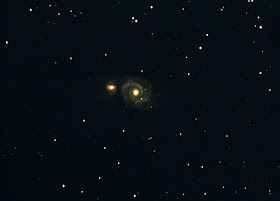As usual when I am on the road (which will happen more than
a few times this summer), you are mostly being cheated out of your accustomed
Sunday read. That may be all to the good this time, however. It gives you a chance to get
out and observe the star object in my next batch of Messiers, M51. The Whirlpool Galaxy is one of the greats, and I’d like to compare notes with you.
What do you need for this spectacular but nevertheless
somewhat challenging galaxy? It can look good in almost any telescope, but it
cries out for a dark sky. Assuming you have that dark sky, my telescope choice is a balance of aperture versus hassle, a 10 – 12-inch Dobsonian, with
the pick for (lazy) me being a 10-inch.
Anyhow, get out to your club dark site or whatever and see
what you can see of its spiral structure, dust lanes, and other
features and those of its companion galaxy, NGC 5195. Can you maybe even spot some
of the other galaxies in the field or nearby (they are admittedly dim and small
and likely a challenge for a 25-inch big gun)? You’ll find out what I was able to scope out next week, and I’m
hoping you will post your observations in the comments section thereafter.

I can't claim to see much through the light pollution here in Huntsville but I did find this one to be an absolute gem when I started video AP last year. What was your setup on the accompanying photo if you don't mind sharing? I'm mostly curious which reducer this is, and what camera, presuming you were in fact using an SCT and hadn't already skipped town on us mirror users.
ReplyDeleteThe setup for this shot was my 80mm William Optics Megrez II Fluorite, VX mount, and Infinity digital video cam. Multiple stacked one minute exposures.
ReplyDeleteRod it has been a pleasure seeing your Messier collection and following your swing to dobs and refractors. I have been casually observing since the 90's. Currently still using my old c14 often; a deforked 8" lx200 (deforked when the electronics inevitably died); very happily an orion ext8 which is extremely portable. Rarely an omni xlt 120. Mounts include an Losmandy G11 (sometimes mounted on an old Meade field tripod when lighter weight is desired:-) and an older Celestron CGE.
ReplyDeleteTwo quick questions. Being least experienced with refractors, I have been surprised at how tall and steady a mount even a small refractor like the 120 seems to require. With shorter mounts I find I end up on my knees or on the ground. Few seem to talk about this. Are there any tricks to using a shorter lighter mount and still not having to be on the ground at zenith?
Second how would you compare views in your 10" dob to the 8" edge? I am probably going to be replacing my old 8" act (it is fairly battered at this point) and wondering about size and image quality these days.
Thanks!!